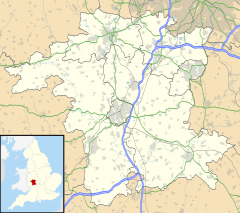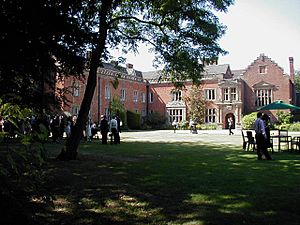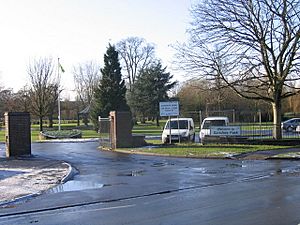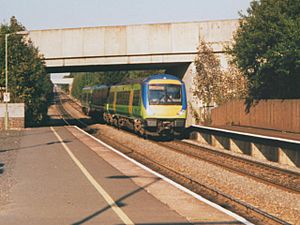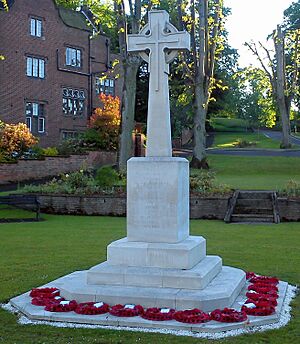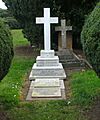Bromsgrove facts for kids
Quick facts for kids Bromsgrove |
|
|---|---|
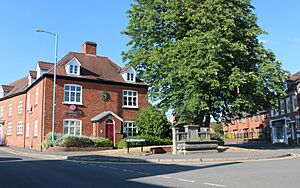 The Strand, Bromsgrove |
|
| Population | 34,755 (Built-up area, 2021) |
| OS grid reference | SO960708 |
| • London | 119 miles (192 km) SE |
| District |
|
| Shire county | |
| Region | |
| Country | England |
| Sovereign state | United Kingdom |
| Post town | BROMSGROVE |
| Postcode district | B60, B61 |
| Dialling code | 01527 |
| Police | West Mercia |
| Fire | Hereford and Worcester |
| Ambulance | West Midlands |
| EU Parliament | West Midlands |
| UK Parliament |
|
Bromsgrove is a town in Worcestershire, England. It's about 16 miles (26 km) north-east of Worcester and 13 miles (21 km) south-west of Birmingham. In 2021, about 34,755 people lived there. Bromsgrove is the biggest town and main center of the wider Bromsgrove District. Long ago, it was a small market town known for making cloth. Later, in the 1700s and 1800s, it became famous for making nails.
Contents
- Bromsgrove's Past: A Look Back in Time
- Bromsgrove's Population: Who Lives Here?
- Bromsgrove's Location and Weather
- Bromsgrove's Economy: How People Make a Living
- Bromsgrove's Facilities: What's Available?
- Entertainment and Arts: What's Happening?
- Clubs and Societies: Getting Involved
- Famous People from Bromsgrove
- Images for kids
- See also
Bromsgrove's Past: A Look Back in Time
Bromsgrove was first written about in the early 800s as Bremesgraf. Later, in 909 AD, it was called Bremesburh. In the famous Domesday Book, it was known as Bremesgrave. The "Breme" part of the name likely comes from an old Anglo-Saxon person's name.
During Anglo-Saxon times, Bromsgrove's economy was based on its woodlands. People hunted, managed hedges, and raised pigs.
When Edward the Confessor was king, Earl Edwin owned the Bromsgrove area. After the Norman Conquest, the King took ownership. Bromsgrove also had 13 salt-making places in Droitwich, which produced a lot of salt. The King could sell his salt before anyone else in the town.
Bromsgrove was the center of a very large church area. Its church, St John the Baptist, was an important church. Bromsgrove and other towns in north Worcestershire helped protect the city of Worcester. They even sent people to help Droitwich in 1086. There might have been old forts in Bromsgrove, but we don't have physical proof.
Bromsgrove first got the right to hold a market day in 1200. In 1317, it was allowed to have a Tuesday market and a three-day fair every August 29th. The market day changed over time, finally settling on Tuesdays from 1792. Fairs were held twice a year by the 1700s, in June and October. Today's fun fairs started from the June horse and pleasure fair.
The area around Bromsgrove became part of Feckenham Forest under King Henry II. This meant it was under special "forest law." This law was removed from Bromsgrove in 1301 by King Edward I, and the forest boundaries moved back.
In the later Middle Ages, Bromsgrove was important for the wool trade. Making cloth, especially narrow cloth and friezes, was first recorded in 1533. However, this industry slowed down by the 1700s. By 1778, about 140 people made linsey (a type of fabric) and 180 made linen. But at the same time, nail making employed 900 people!
Nail making started in the 1600s, brought by French Huguenots. It became a very successful industry. At one point, Bromsgrove was the world's main center for nail making. But machines soon took over, and the industry declined.
The Bromsgrove Workhouse, a place for poor people to live and work, opened in 1838 and closed in 1948. Today, it's an office building.
In 1841, the Bromsgrove railway works opened. This was mainly a place to fix trains, but they also built steam locomotives. The works gave many people jobs in Bromsgrove. In 1964, the works closed and were taken down. Now, the area is a housing estate. You can still see one of the old turntable pits.
The Norman and 13th-century St. John the Baptist church was greatly repaired in 1858 by Sir George Gilbert Scott. In the churchyard, you can find the graves of two railway workers, Tom Scaife and Joseph Rutherford. They died when their steam train exploded while climbing the very steep Lickey Incline on November 10, 1840.
St. Peter's Roman Catholic Church on Worcester Road was built in 1858 by Gilbert Blount.
For many years, Bromsgrove was home to the famous Bromsgrove Guild of Applied Arts. This group of skilled craftspeople created beautiful sculptures and metalwork. Their work includes the gates of Buckingham Palace and a famous statue at the Fortune Theatre in Drury Lane.
Bromsgrove's Population: Who Lives Here?
In 2001, Bromsgrove town had 29,237 people. The larger Bromsgrove District had 87,837 people, which grew to 99,200 by 2021. Most people in Bromsgrove are White British.
Bromsgrove's Location and Weather
Bromsgrove's ground is made of a type of Sandstone from the Triassic period. This rock was likely formed by rivers in a dry area or in shallow, temporary lakes. The top layers were formed when the sea briefly covered the land. The soil is very good for growing vegetables because of its Marl bands. The area is generally between 200 and 300 feet (61 to 91 meters) above sea level.
Bromsgrove's Climate: What's the Weather Like?
Bromsgrove has an oceanic climate, which is typical for most of the United Kingdom. This means it has mild temperatures and rainfall throughout the year.
| Climate data for Bromsgrove | |||||||||||||
|---|---|---|---|---|---|---|---|---|---|---|---|---|---|
| Month | Jan | Feb | Mar | Apr | May | Jun | Jul | Aug | Sep | Oct | Nov | Dec | Year |
| Mean daily maximum °C (°F) | 7 (45) |
8 (46) |
11 (52) |
13 (55) |
16 (61) |
19 (66) |
22 (72) |
22 (72) |
18 (64) |
14 (57) |
10 (50) |
7 (45) |
14 (57) |
| Mean daily minimum °C (°F) | 3 (37) |
2 (36) |
4 (39) |
4 (39) |
7 (45) |
10 (50) |
12 (54) |
12 (54) |
10 (50) |
8 (46) |
5 (41) |
3 (37) |
7 (45) |
| Average precipitation mm (inches) | 37.6 (1.48) |
25.4 (1.00) |
24.3 (0.96) |
32.4 (1.28) |
27.1 (1.07) |
35.8 (1.41) |
31.0 (1.22) |
38.5 (1.52) |
39.9 (1.57) |
43.8 (1.72) |
36.7 (1.44) |
33.1 (1.30) |
405.6 (15.97) |
Famous Sights: What to See in Bromsgrove
You can see a statue of the poet Alfred Edward Housman in the high street. It was put there in 1985. There's also a sculpture of a dryad (a tree spirit) and a boar in the high street. This sculpture celebrates the work of the Bromsgrove Guild.
Bromsgrove is home to Grafton Manor, a historic house from the 1300s. It has an interesting past, including a connection to the Gunpowder Plot.
Bromsgrove's Economy: How People Make a Living
In 2004, about 33,175 people in Bromsgrove District had jobs. The biggest job areas in 2001 were manufacturing (making things), retail (shops), and services.
Many people who live in Bromsgrove work in nearby cities like Birmingham, Redditch, and Worcester. MG Rover, a car company, used to employ many Bromsgrove residents until it closed in 2005. Bromsgrove is still home to LG Harris Ltd, a company that makes paint brushes. New business parks are helping to create more jobs in the area. The Bromsgrove District Council wants to create a "technology corridor" along the A38 road, using the area's good road connections.
Bromsgrove's Facilities: What's Available?
Town Services: Public Buildings and Parks
Bromsgrove has a public library in the town center. You can find books, music CDs, audiobooks, and DVDs there. It also has computers with internet access.
Sanders Park is a public park in Bromsgrove. It has basketball and tennis courts, a skate park, a children's play area, and football pitches. Every year, there's a bonfire night with fireworks and fairground rides. The park also hosts other events, like big band concerts.
The Bromsgrove Sports and Leisure Centre (formerly The Dolphin Centre) is a large public sports center. It has two swimming pools and a big sports hall. Many activities and clubs, like the Bromsgrove Swimming Club, take place here. The center was updated in 2017.
Getting Around: Transport in Bromsgrove
Bromsgrove is crossed by the A38 road, which was given a bypass in 1980. The M5 motorway is on the west side, and the M42 motorway starts north of the town.
Bromsgrove railway station is south of the town. It's at the bottom of the Lickey Incline, which is the steepest main railway line in England. This means most freight trains need an extra locomotive to help push them up the hill. There are frequent trains to Birmingham New Street, Worcester Foregate Street, and Hereford. A new station was built and opened in July 2016. Now, electric trains run from Bromsgrove on the Cross City Line towards Lichfield.
There's also a bus station next to the High Street. Buses go to places like Redditch, Worcester, and Kidderminster. The historic 144 bus service used to go all the way to Birmingham, but now it stops at Catshill. A new service, the 20, runs between Bromsgrove and the Queen Elizabeth Hospital.
Bromsgrove is on National Cycle Route 5 and is the end point for cycle route 46. You can find public bike stands in the town center.
Learning in Bromsgrove: Schools and Colleges
Bromsgrove schools use a "three-tier" system: first school (for younger kids), middle school, and high school.
There are 15 first schools in the district, including Lickey End First School and Finstall First School. There are five middle schools, such as Aston Fields Middle School and St John's Church of England Middle School Academy.
Bromsgrove has two high schools: North Bromsgrove High School and South Bromsgrove High School. South Bromsgrove is known for foreign languages and IT. North Bromsgrove High School specializes in media and creative arts. Both schools were rebuilt in 2007.
Private Schools
Bromsgrove School is a private school founded in 1553. It teaches students from nursery age up to sixth form (the last two years of high school) and offers boarding. Famous former students include Digby Jones and actors Ian Carmichael and Trevor Eve.
Special Schools
Bromsgrove has two special schools: Chadsgrove School and Specialist Sports College, and Rigby Hall School.
College Education
Bromsgrove is the main campus for Heart of Worcestershire College. In 2011, the college built a motorcycle academy with help from a grant.
Sports and Activities: Getting Active in Bromsgrove
Bromsgrove is home to many sports clubs:
- Fairfield Villa Football Club.
- Bromsgrove Rugby Football Club, one of the oldest rugby clubs in the country, started in 1872.
- Bromsgrove Sporting Football Club, who play at The Victoria Ground.
- Bromsgrove Cricket, Hockey, and Tennis Club.
- Mercian Divers Scuba Diving Club.
- North East Worcestershire Ravens rugby league club.
- Bromsgrove Indoor Bowls Club.
- Bromsgrove and Redditch Athletics Club.
- Bromsgrove Swimming Club, started in 1966.
- Worcester City Football Club also plays its home games at The Victoria Ground.
Fun Places to Visit: Attractions in Bromsgrove
The Avoncroft Museum of Historic Buildings is in Bromsgrove. This museum has old buildings from different times, including a collection of old Telephone Kiosks. The Bromsgrove Museum on Birmingham Road reopened in May 2016.
The Worcester and Birmingham Canal is close to Bromsgrove and is a great place for walks and coarse fishing. You can also rent narrowboats in nearby villages. The Tardebigge lock flight, with 30 locks, is the longest in the UK. Bromsgrove is also about 5 miles (8 km) from Hanbury Hall, a historic country house that you can visit.
The town has entertainment spots like a nightclub and many pubs, including a Wetherspoons and a Slug and Lettuce.
Bromsgrove is also near beautiful countryside areas like the Lickey Hills, the Clent Hills, and the Waseley Hills.
Entertainment and Arts: What's Happening?
Bromsgrove used to have an arts center called Artrix. It opened in 2005 and hosted theater, movies, concerts, comedy shows, and classical music. It also had a youth theater group. Artrix closed in 2022 due to the COVID-19 pandemic. However, in 2023, another theater group started using the building, and now Bromsgrove Community Art runs it.
The 2015 World War II film Our Father was partly filmed near Bromsgrove. The 2023 film The Shamrock Spitfire was also partly filmed at Avoncroft Museum and Hanbury Church.
North of town, in Fairfield village, Bromsgrove Arts has been showing movies and hosting live music and drama events since 2019.
Bromsgrove Festival: A Musical Tradition
Since 1960, Bromsgrove has held an annual classical music festival that is known internationally.
Clubs and Societies: Getting Involved
Bromsgrove has a ceremonial group called the Court Leet. The Bromsgrove Society is a charity started in 1980 to protect the town's buildings and nature. The Bromsgrove Society of Model Engineers, formed in 1982, has a track at the Avoncroft Museum of Historic Buildings. The Bromsgrove Photographic Society, started in 1950, organizes talks. Bromsgrove also has a Rotary Club that began in 1936.
Town Twinning: Friends Across the World
In May 1980, Bromsgrove became "twinned" with Gronau, a town in Germany. This means they have a special friendship. In July 1999, Bromsgrove also formed a friendship link with Saint-Sauveur-Lendelin in France. People from Bromsgrove and these towns visit each other every year.
Twinning
 Gronau, Germany
Gronau, Germany
Friendship Link
Famous People from Bromsgrove
Many interesting people have come from Bromsgrove, including those who went to Bromsgrove School.
People from the Past (Medieval to 19th Century)
- Richard Bromsgrove: An important church leader.
- Sir John Talbot: An owner of Grafton Manor, buried in Bromsgrove.
- William Dugard: A schoolmaster and writer in the 1600s.
- John Hall: An Anglican bishop.
- Sarah Bache: A hymn writer, born around 1771.
- Charlotte Badger: Thought to be the first Australian female pirate, born in 1778.
- George Cadbury: The creator of Cadbury chocolates.
- Alfred Edward Housman: A famous classical scholar and poet.
- Mabel Tolkien: The mother of J. R. R. Tolkien (who wrote The Lord of the Rings), is buried in Bromsgrove.
People from Recent Times (20th and 21st Century)
- Michael Ball: A singer and actor, born in Bromsgrove.
- Jude Bellingham: An England footballer, lived in Bromsgrove.
- Michael Buerk: A BBC News presenter, once worked for the local Bromsgrove Messenger newspaper.
- Dan Bull: An internet activist and musician, born in Bromsgrove.
- Nicola Charles: An actress, born in Bromsgrove in 1969.
- Jonathan Coe: An author, born near Bromsgrove in 1961.
- Fyfe Dangerfield: A musician, grew up in Bromsgrove.
- Nicholas Evans: The author of The Horse Whisperer, born in Bromsgrove.
- Craig Fagan: A footballer, lived in Bromsgrove as a child.
- Anthony E. Pratt: The inventor of the board game Cluedo, is buried in Bromsgrove Cemetery.
- Pat Roach: A wrestler and actor, buried in Bromsgrove Cemetery.
- Gary Rowett: A former professional footballer and manager.
- Trudie Styler: An actress and producer, born in Bromsgrove.
- Sir John Vane: A pharmacologist who won the Nobel Prize in Physiology or Medicine in 1982, born near Bromsgrove.
- Jessica Varnish: A track cyclist.
- Mark Williams: An actor famous for playing Arthur Weasley in the Harry Potter films.
- Ben Francis: An entrepreneur and co-founder of Gymshark.
- Megan Walsh: A footballer for the Republic of Ireland national team.
Images for kids
-
Grave of Mabel Tolkien, mother of J. R. R. Tolkien, in Bromsgrove
See also
 In Spanish: Bromsgrove para niños
In Spanish: Bromsgrove para niños


